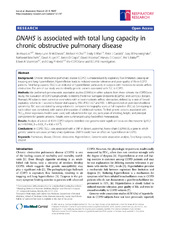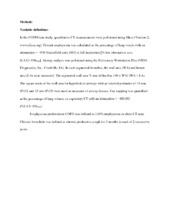| dc.description.abstract | Background: Chronic obstructive pulmonary disease (COPD) is characterized by expiratory flow limitation, causing air trapping and lung hyperinflation. Hyperinflation leads to reduced exercise tolerance and poor quality of life in COPD patients. Total lung capacity (TLC) is an indicator of hyperinflation particularly in subjects with moderate-to-severe airflow obstruction. The aim of our study was to identify genetic variants associated with TLC in COPD. Methods: We performed genome-wide association studies (GWASs) in white subjects from three cohorts: the COPDGene Study; the Evaluation of COPD Longitudinally to Identify Predictive Surrogate Endpoints (ECLIPSE); and GenKOLS (Bergen, Norway). All subjects were current or ex-smokers with at least moderate airflow obstruction, defined by a ratio of forced expiratory volume in 1 second to forced vital capacity (FEV1/FVC) <0.7 and FEV1 < 80% predicted on post-bronchodilator spirometry. TLC was calculated by using volumetric computed tomography scans at full inspiration (TLCCT). Genotyping in each cohort was completed, with statistical imputation of additional markers. To find genetic variants associated with TLCCT, linear regression models were used, with adjustment for age, sex, pack-years of smoking, height, and principal components for genetic ancestry. Results were summarized using fixed-effect meta-analysis. Results: Analysis of a total of 4,543 COPD subjects identified one genome-wide significant locus on chromosome 5p15.2 (rs114929486, β =0.42L, P =4.66 × 10−8). Conclusions: In COPD, TLCCT was associated with a SNP in dynein, axonemal, heavy chain 5 (DNAH5), a gene in which genetic variants can cause primary ciliary dyskinesia. DNAH5 could have an effect on hyperinflation in COPD. | en_US |


